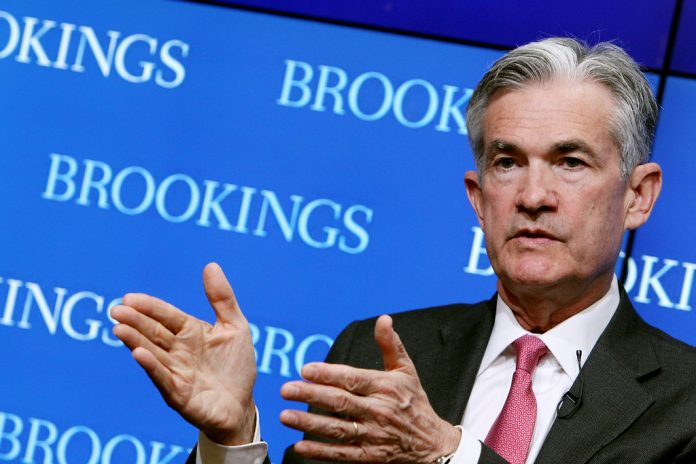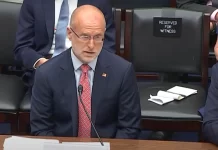The United States is experiencing the highest inflation in 40 years. The Federal Reserve has finally started raising interest rates to get inflation under control. However, higher interest rates have the negative side effect of reducing the value of the securities owned by the Fed, which could inhibit its monetary policy and result in losses to the U.S. Treasury and therefore to American taxpayers.
Among Federal Reserve officials and many economists, it is fashionable to argue that Federal Reserve system losses, no matter how large, will have no operational consequence for Fed monetary policy but could create “communications challenges.” Fed Chair Jerome Powell recently testified that unrealized losses on the Fed’s securities portfolio “play no role in our decision making [and] have no effect at all on our ability to conduct monetary policy.”
We are about to learn if this is true. Since it started raising interest rates, the Fed has already experienced mark-to-market losses of epic proportions, and will soon face large operating losses, something it has never seen in its 108-year history.
We estimate that at the end of May 2022, the Federal Reserve had an unrecognized loss of about $540 billion on the market value of its $8.8 trillion System Open Market Account (SOMA) portfolio of Treasury bonds and mortgage securities. This loss, which will only get larger as interest rates increase, is equivalent to 60 percent of the Fed’s total assets in early September 2008, and more than 13 times the Federal Reserve System’s current reported consolidated capital of $41 billion. The Fed’s liabilities—primarily Federal Reserve notes and member bank reserve balances—are half a trillion dollars larger than the market value of the assets the Fed owns.
Any other financial institution this economically insolvent would be closed, but unlike regulated banks and other financial institutions, no matter how big the losses it may face, the Federal Reserve will not fail and can continue to print money even while deeply insolvent. But this does not mean that Fed losses will never have an impact on its ability to conduct monetary policy.
The Federal Reserve Board sets its own accounting rules, which are used to calculate the Fed’s income and report its financial condition. The Board has decided that, when it calculates income, it will not recognize mark-to-market losses on its giant securities portfolio. The Fed includes two types of losses in its reported income: realized losses on its securities and foreign exchange positions, and operating losses.
The Fed accounts for the securities it owns on an amortized cost basis, meaning it records a book value equal to a security’s par value plus the amortized premium (discount) it paid (received) when it purchased the security. If the Fed sells a security for more or less than its amortized cost, it generates a realized gain or loss in reported income. The primary components of the Fed’s operating income (loss) are: interest income, less interest expense; plus (minus) realized gains (losses) on securities and foreign exchange; less Federal Reserve district bank and Federal Reserve Board operating expenses; less the cost of funding the Bureau of Consumer Financial Protection. Operating expenses for district banks, the Board of Governors and the CFPB run about $9 billion annually.
The story of how the Fed accounts for losses, how the losses may impact monetary policy, and who ultimately pays for these losses is a complicated one. Federal Reserve system member banks must subscribe to the shares issued by their district bank in a dollar value equal to 6 percent of a member institution’s paid-in capital and surplus. Member banks only pay for half the subscribed shares “while the remaining half of the subscription shall be subject to call by the Board.” Each member bank must true up its district bank stock subscription annually to reflect changes in the member bank’s capital and surplus.
Under the Federal Reserve Act, in addition to being subject to calls to buy more Federal Reserve bank stock, member banks are also required to contribute additional funds to cover district reserve bank annual operating losses in an amount not to exceed twice the par value of their Federal Reserve district bank stock subscription. Note especially the use of the term “shall” and not “may” in the Federal Reserve Act:
“The shareholders of every Federal reserve bank shall be held individually responsible, equally and ratably, and not one for another, for all contracts, debts, and engagements of such bank to the extent of the amount subscriptions to such stock at the par value thereof in addition to the amount subscribed, whether such subscriptions have been paid up in whole or in part under the provisions of this Act.” (emphasis added)
Despite congressional revisions to the Federal Reserve Act over more than a century, the current Act still contains this exact passage. Until now, the Federal Reserve System posted an operating loss in only a single year, 1915. At that time, the Board voted to approve a call on member bank resources to cover the loss, but the district reserve banks failed to do so because they feared a call would discourage state banks from joining the Federal Reserve system.
By the FOMC’s own estimates, short-term policy rates will approach 3.5 percent by the end of 2022. Several bank economists think the FOMC is overly optimistic and project that higher policy rates, maybe much higher, will be needed before the Fed successfully contains surging inflation. The level of short-term interest rates is important because our estimates suggest that the Federal Reserve will begin reporting net operating losses once short-term interest rates reach 2.7 percent. This estimate assumes the Fed has no realized losses from selling SOMA securities. If the Fed were to sell a significant amount of securities from its $8.8 trillion SOMA portfolio, given that the average interest rate on securities in this portfolio is only slightly more than 1.7 percent, the Fed would book operating losses long before short-term interest rates reach 2.7 percent. Ignoring mark-to-market losses and absent any realized losses from SOMA asset sales, we project that the Fed would post an annualized operating loss of $62 billion should short-term rates rise to 4 percent. Such a loss is equivalent to 150 percent of the Federal Reserve system’s total capital.
This unenviable financial situation in which the Fed has placed itself—huge mark-to-market investment losses and possibly negative operating income—is the predictable consequence of the balance sheet the Fed owns as it transitions to an inflation-fighting monetary policy. The Fed will pay rising rates of interest on bank reserves and reverse repurchase transactions after more than a decade of Fed quantitative easing and zero interest rate policies stuffed the Fed’s balance sheet with low-yielding long-term fixed-rate securities. The Fed’s earning dynamics now resemble those of a typical failing 1980s savings and loan.
In 2011, the Federal Reserve announced its official position regarding realized losses on its SOMA portfolio and system operating losses is,
“[I]n the unlikely scenario in which realized losses were sufficiently large enough to result in an overall net income loss for the Reserve Banks, the Federal Reserve would still meet its financial obligations to cover operating expenses. In that case, remittances to the Treasury would be suspended and a deferred asset would be recorded on the Federal Reserve’s balance sheet, representing a claim on future net earnings that the Reserve Banks would need to realize before remittances to the Treasury would resume.”
At the time it explained its strategy for managing realized losses, the Federal Reserve Board apparently had not considered the possibility that its interest expense could drive its operating earnings negative even without any realized losses on SOMA portfolio sales.
The Federal Reserve Board’s official position on losses is: (1) it does not recognize mark-to-market losses on its SOMA securities; (2) should it face operating losses, it would not reduce its paid-in book capital and retained surplus, but instead would just create the money needed to meet operating expenses and offset the newly printed money by creating an imaginary “deferred asset” on its balance sheet; and (3) subsequently, in the future, as the reserve banks start making positive operating earnings, after paying member bank dividends, the Fed will reduce the deferred asset balance to zero before resuming their remittance payments to the US Treasury. In the meantime, the Treasury and the budget deficit will miss their accustomed remittance payments from the Fed.
All Fed member banks were originally entitled to receive a generous 6-percent dividend on the par value of their paid-in shares. The dividend is cumulative in the event a district bank has insufficient operating revenues to cover expenses and dividends in any given year. More recently, the dividend rate was reduced for large banks, currently defined to be banks with assets in excess of $11.2 billion. The annual dividend rate for these banks is the lesser of, “the high yield of the 10-year Treasury note auctioned at the last auction held prior to the payment of such dividend, or 6 percent.”
Under the Fed’s current stated policy accounting for operating losses, the Federal Reserve’s reported capital and surplus will not be depleted by operating losses. According to the Financial Accounting Manual for Federal Reserve Banks (p. 201), bank dividend payments will continue to be paid as long as a reserve bank has a positive surplus account, a fate that would seem to be ensured under the “deferred asset” accounting entry district reserve banks will book to offset an operating loss.
The Fed’s somewhat cavalier treatment of its impending losses is curious since it is at odds with the way Federal Reserve system losses should be treated according to the Federal Reserve Act. Moreover, given the growing interest income banks will earn on their reserve balances, the issue of burden sharing of Federal Reserve System losses is likely to become more contentious as the Fed executes inflation-fighting policies that will directly benefit the member banks that own the 12 Federal Reserve district banks.
The issue of maintaining a positive Federal Reserve system capital cushion was once a necessity to maintain public confidence in convertibility under the international gold standard. It is often argued that the size of the Fed’s loss absorbing capital cushion is no longer an issue of practical importance since Federal Reserve notes and member bank reserve bank balances have not been convertible into gold for almost 90 years. The pure fiat currency the Federal Reserve issues today has no commodity backing and there is no longer any constraint on the amount the Fed can issue. Given the Fed’s stated intention to monetize operating losses and back any newly created currency with imaginary “deferred assets,” the Fed has demonstrated it no longer has a concern in maintaining the market value of the assets backing its capital and surplus accounts.
The Federal Reserve Board’s proposed treatment of system operating losses is inconsistent with the treatment prescribed by the Federal Reserve Act. In all likelihood, operating losses, should they occur, will in large part be a consequence of the interest payments on member banks’ reserve balances. The original authors of the Federal Reserve Act would never have approved of allowing the Fed to create an imaginary “deferred asset” as a mechanism to hide the fact that the Fed is depleting its cushion of loss-absorbing assets while paying banks interest on their reserve balances, since the Act itself requires member banks as stockholders to be liable for Federal Reserve district bank operating losses.
If the Federal Reserve were required to comply with the language in the Federal Reserve Act and assess the member banks to cover operating losses, monetary policy could be significantly impacted in a number of ways. Just as it did in 1915, the issue of imposing operating losses on member banks would focus the attention of the district bank presidents who vote on FOMC monetary policies to answer to the member banks who own stock and elect the district bank board members who select the reserve bank president.
As short-term interest rates rise and the interest expense needed to fund reverse repurchase agreements and member bank reserve balances consumes more of the interest earnings on its SOMA portfolio, the FOMC may become reluctant to shrink its balance sheet by liquidating SOMA assets at a loss. The prospect of passing Federal Reserve system operating losses on to member banks could create pressure to avoid losses by limiting the interest rate paid to member banks. Should this occur, it would directly impact the FOMC’s primary monetary policy tool for constraining inflation. Moreover, some member banks’ capital positions could become tenuous should the Federal Reserve Board require district reserve banks to pass large operating losses on to their shareholders.
Under its post-crisis monetary operating policies, as the Fed raises rates, banks will earn larger interest payments on their reserve balances held at the Fed district banks while continuing to accrue dividends on their Federal Reserve district bank shares. Meanwhile, the Fed’s actions will impose higher interest rates on the public at large, losses in the value of the public’s bonds and stocks held in savings and retirement accounts, reduced growth, and likely a significant increase in unemployment before the Fed successfully arrests the inflationary pressures stoked by its prior policies. If the Fed’s monetary policies lead to Federal Reserve system operating losses, and the Fed follows its plan to monetize these losses, the losses will only contribute to the inflationary pressures the Fed seeks to control.
Once the public understands the implications of the Fed’s mark-to-market losses and its potential future operating losses, its proposed policy to monetize these losses, and how existing laws, if enforced, would benefit its stockholding member banks, we agree that the Fed is likely to face a serious communications challenge.
Originally published by the American Institute for Economic Research. Republished with permission under a Creative Commons Attribution 4.0 International License.
More great content from Budget & Tax News










